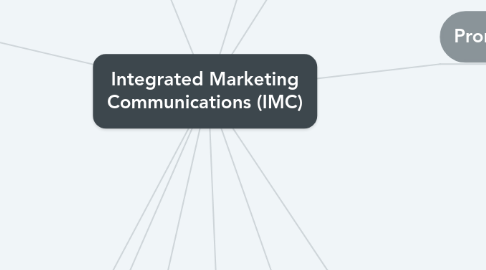Integrated Marketing Communications (IMC)
por Soong Huini


1. What is promotion?
1.1. Communications link between buyers and sellers.
1.1.1. New vocabulary
1.2. Functions of informign, persuading, and influencing, a consumer's purchase decision
2. Elements of promotional mix
2.1. Personal Selling
2.1.1. -interpersonal influences process involving a seller's promotional presentation conducted on a person-to-person basis with buyers. Such as promoter, salesperson.
2.2. Non-Personal selling
2.2.1. Element of non-personal selling: 1)advertising 2) Product placement 3)Sales Promotion 4)Direct Marketing 5)Public Relations and Publicity 6) Guerilla Marketing
3. 5 objectives of promotion
3.1. 1) provide information -as a traditional ways to inform the availability of a particular goods or services -can helps differentiate a product from its competitors by focusing on its benefits and features.
3.2. 2) Increasing the demand -included 2 types of demand: i) primary demand -typical for firms holding exclusive patents or significant product improvement and for marketers who decide to expand overseas or creating new markets. ii) Selective Demand -desires for a specific brand such as beauty and cosmetic brands
3.3. 3)Differentiate the product -for homogeneous product, marketers will differentiated their product in marketing strategy. Example: changes in prices
3.4. 4) Accentuate the product's value -objectives benefits the both consumers and business product. -firm's promotional messages must build brand image and equity and at the same time deliver purchases action.
3.5. 5)Stabilize sales -sales are not uniforms throughout the year that may result from cyclical, seasonal or irregular demand. -Such as school holidays, tickets prices for citizens and non-citizens
4. Sponsorships
4.1. Event sponsor relation relationship in which an organisations funds or in-kind resources to an event or activity in exchange for direct association with the event
4.2. For example, big companies lend a hand in making international and national events a success.
5. Direct Marketing
5.1. -helps increases store traffic -opens new international markets of unprecedented size.
5.2. communications channels for direct marketing: i) direct mail ii) catalogs iii) Telemarketing iv) Broadcast Channels v) electronic direct marketing channels vi) Others, such as print media and kiosks
6. Factors that influences effectiveness of promotional mix
6.1. i) the nature of market ii) the mature of product iii) the stage in product life cycle iv) the price v) funds that are available for promotion
7. Promotion communication process
7.1. 1) Marketing manager
7.2. 2) Transmit messages such as sales presentations, ads, displays, direct mails, and publicity releases
7.3. 3)Delivers message via salesperson, print and electronic advertising media and public realtions
7.4. 4) Receiver or customers interprets message
7.5. 5)Receiver or customer makes decisons
7.6. 6) Customers responses to market research,market share changes or field search report.
7.7. 3 tasks to accomplishes by an effective message: i) gain receiver's attention ii)achieves the understanding by both receiver and sender iii)stimulates the receiver's need and suggest an appropriate method to satisfy them.
8. What is AIDA Concept?
8.1. the steps consumer take in reaching a purchase decision
8.1.1. Research and prepare experiment
8.2. promotional message must gain potential customers attention.
8.2.1. stimulate the desires by convicing the potential customers of product's satisfy his/her needs
8.2.1.1. salesperson uses technique to attempt customer to make purchase action.
8.3. it is vital to online marketers
9. What is IMC?
9.1. coordination of all promotional activities to produce a unifies,customer-focused promotional message.
10. Why teamwork is important in IMC?
10.1. -IMC is the total strategy in promotional that required a strong teamwork in all marketing activities.
10.2. -A team must present a consistent, coordinated promotional effort at every point of customer contact with the organisation.
10.2.1. could save time and avoid duplication of effort, and increasing marketing effectiveness

